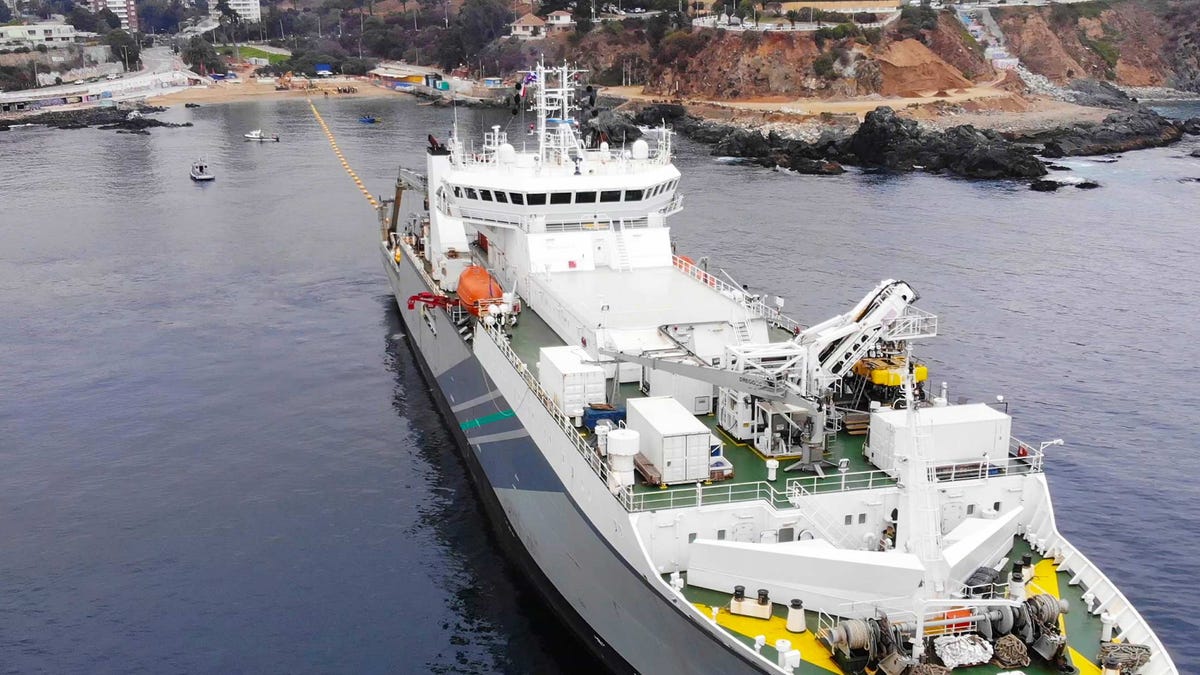Google subsea cable will handle data surge between US, Brazil, Argentina
Cable manufacturer SubCom is making the Firmina fiber optic cable this year and installing it in 2022. It should start carrying data in 2023.

A ship lays down a Google undersea cable
Google is building a new subsea cable to shuttle your megabits between between the eastern US, Brazil, Uruguay and Argentina. The fiber optic line, called Firmina after a Brazilian abolitionist, is due to start operations in 2023.
"Internet infrastructure is not in the cloud, it's under the ocean," said Bikash Koley, vice president of global networking at Google. Firmina is the 16th submarine cable Google has built or invested in. "The internet is still growing steadily year over year. I expect that train to continue," he said.
Adding capacity is important to accommodate consumer services like search, Gmail and YouTube, and business infrastructure like Google Cloud. About 98% of international data travels on submarine cables draped across the bottom of oceans and seas, Google said, and Google Meet videoconferencing surged by a factor of 25 when the coronavirus pandemic struck.
As it does with its daily Google Doodles, Google pays homage to notable figures with its submarine cable names. This cable is named for Maria Firmina dos Reis, a mixed-race author who wrote about the lives of Afro-Brazilian slaves in her 1859 novel, Úrsula. Google also spotlighted her 194th birthday with a Google doodle in 2019.
Google names its own subsea cables in alphabetical order -- mostly. Its most recently announced subsea cable is called Grace Hopper after the pioneering computer scientist and discoverer of an actual bug in an early computer. "The sequence was a little off," Koley said of the naming order. Earlier Google cables are named Curie, Dunant and Equiano.
Google didn't share the expected data capacity of the cable, but it'll carry data on 12 pairs of fiber optic lines over thousands of miles. For comparison, the Grace Hopper cable, with 16 pairs, has a capacity of 250 terabits per second with 16 fiber pairs linking the US to the UK and Spain.
Google's Firmina subsea cable route will link the US to Brazil, Uruguay and Argentina.
That's about 250,000 times faster than even fast gigabit-per-second broadband using fiber optic lines. Subsea cables can cram on more data by using more fiber optic lines and with more expensive terminals that take advantage of more light frequencies and other signal processing tricks to squeeze on more data, Koley said.
Google hired SubCom to design and install the cable. It'll manufacture the cable this year at its facility in Newington, New Hampshire, and install the cable during the summer of 2022, SubCom said in a statement.
Submarine cables must boost signal strength about every 100 kilometers (62 miles), and power lines bundled within the cable supply the power. One unusual aspect of Firmina is that it can be powered from either end of the cable, increasing reliability over more common designs that rely on power from both ends all the time, Koley said.
This approach, which SubCom calls single-end feed power, requires an 18-kilovolt power supply -- about 20% higher than conventional designs. SubCom expects Firmina to be the longest cable to use the technology.
Google hasn't yet selected the site for the US cable terminal. Its southern destinations are Las Toninas in Argentina, Praia Grande in Brazil and Punta del Este in Uruguay.
Google participates in partnerships with other cable operators, swapping capacity on similar routes to strengthen the overall lattice of communication links.

